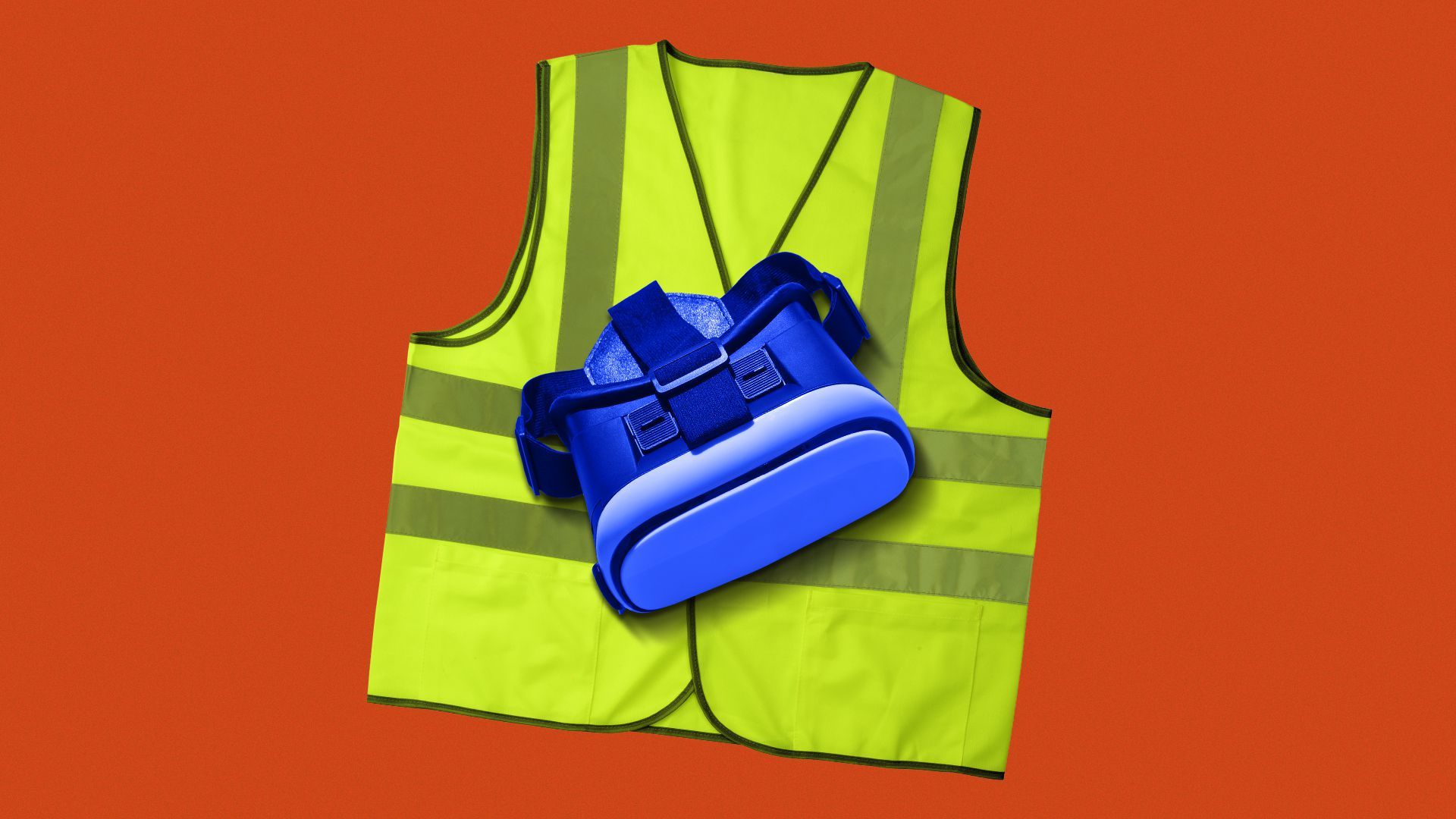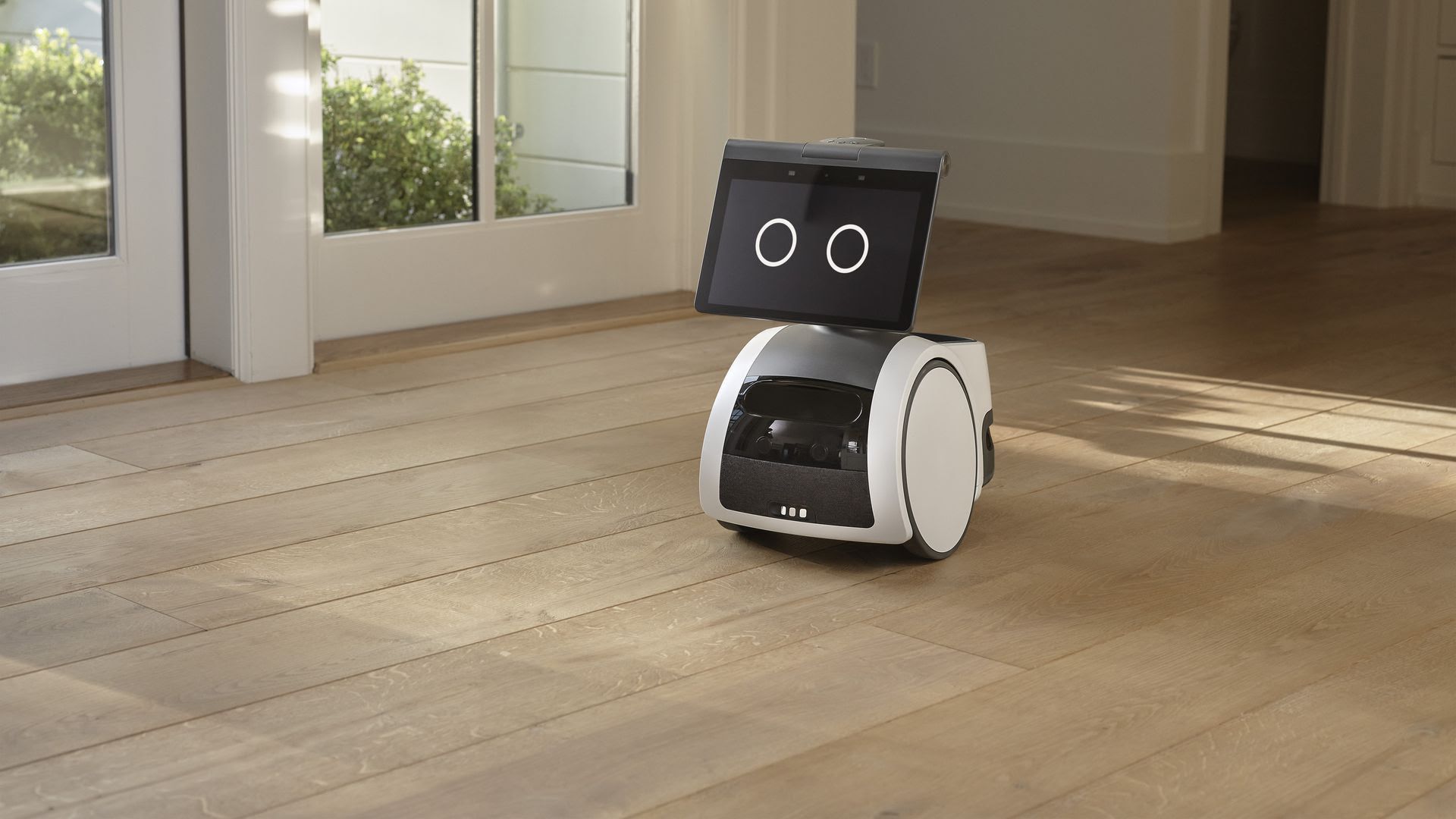| | | | | | | Presented By Hewlett Packard Enterprise | | | | Axios Future | | By Bryan Walsh ·Sep 29, 2021 | | Welcome to Axios Future, where I'm undergoing an intensive virtual reality training system — mostly playing Beat Saber — to better bring you this newsletter. Today's Smart Brevity count: 1,735 words or about 6½ minutes. | | | | | | 1 big thing: Virtual reality isn't all fun and games |  | | | Illustration: Rae Cook/Axios | | | | Tech companies dream of creating a virtual reality metaverse, but the current best use of VR is something far more quotidian: job training. The big picture: VR offers everyone from NFL quarterbacks to Walmart sales associates a relatively inexpensive, scalable way to practice their job skills within a programmable virtual space. What's happening: Even as VR has lagged on wider uses, workplace training is emerging as an immediate business case for the technology. - Worldwide spending on augmented and virtual reality training systems topped $1.3 billion in 2020 — close to half of all investments in immersive technology, which also includes uses like gaming.
- According to a survey by software marketplace Capterra, 1 in 3 small- or medium-sized businesses in the U.S. plan to pilot a VR training program.
What they're saying: "Facebook and many other companies are doing really cool things with social VR and the gaming metaverse," says Derek Belch, CEO of the industry-leading VR training company Strivr. "But I personally feel that for the next five years, training will continue to be the low-hanging fruit." How it works: Belch began working on what would become Strivr while serving as a graduate assistant for Stanford University's football team in 2013, which allowed him to see how VR could help athletes practice their sport without needing their teammates or putting themselves at risk of injury. - Strivr now works with pro sports teams in multiple leagues, using 360-degree cameras to capture footage of plays and practices that players — including Tom Brady, who began using Strivr before his Super Bowl-winning season with the Tampa Bay Buccaneers in 2020 — can later run through in VR.
- "When they put the headset on, they feel like they're in the pocket and all this stuff is flying around them," says Belch. "They can go through their pre-snap motions and footwork, just without throwing the ball."
"VR is visualization practice on steroids." — Derek Belch, Strivr Details: A call from Walmart in 2016 led Strivr to expand its VR offerings beyond sports, and today there are 17,000 VR headsets in Walmart stores for employee training. - In recent months, Walmart has begun using VR not just to train its associates in the physical details of their jobs, but in helping them respond to pandemic-stressed customers with more empathy through programs that have workers interact with a VR avatar.
- "It's about having the experience of putting myself in [someone else's] shoes before it even happens," Heather Durtschi, Walmart's senior director of learning, content design and development, said in a recent webinar.
By the numbers: VR training can help workers master both hard and soft skills better and faster — a 2020 PwC study found VR learners are four times more focused than e-learning students and 275% more confident in applying skills after training. - After Honeywell began using a mix of virtual and augmented reality tools to train its industrial workers, training time fell by more than 60%.
The catch: While cheaper and faster, VR training programs lack the flexibility that can come with live instruction. And as many as 40% of users experience some degree of motion sickness in VR and AR environments, with women reporting worse side effects. The bottom line: Virtual reality is still awaiting the iPhone moment that will drive broad consumer adoption — and perhaps one day lead to the metaverse — but in the meantime, think of VR training as a perfectly practical Blackberry experience. Read the entire story. |     | | | | | | 2. Study: Declining fertility rates are a matter of choice |  | | | Illustration: Shoshana Gordon/Axios | | | | A new study posits one explanation for the dramatic drop in birth rates in the U.S.: shifting priorities among young adults. Why it matters: If the fall in the U.S. birth rate is largely driven by changing life priorities among people of child-bearing age, it limits any steps that might be taken to reverse the trend. By the numbers: Between 1980 and 2007, U.S. birth rates stayed within a narrow range of roughly 65–70 births per 1,000 women aged 15–44. - But between 2007 and 2020, birth rates plummeted by about 20%, falling to 55.8 last year.
- "Aside from the impact of the Great Recession, which contributed to the decline for the first few years of this period, we are unable to identify a strong link between any specific policies or economic factors and the declining birth rate," a group of economists from the University of Maryland and Wellesley College write in a working paper published in the National Bureau of Economic Research.
Instead, the authors settle on one possible explanation: Young adults would rather be doing something else with their lives. How it works: The U.S. could be undergoing a "second demographic transition," following the first transition of very high to lower fertility levels — as well as lower infant mortality rates — that occurred during the Industrial Revolution. - The new transition puts a "greater emphasis on individual autonomy" while de-emphasizing marriage and parenthood, the authors write.
- At the same time, the act of "parenting" — which only became a commonly used verb in the 1970s — came to be seen as more resource- and time-intensive, "clashing with career aspirations or a desire for more leisure time," they note.
Read the rest. |     | | | | | | 3. This is your brain on streaming audio |  | | | Illustration: Sarah Grillo/Axios | | | | A new study done for Spotify shows the surprisingly engaging effect of digital audio and ads on the human brain. Why it matters: Neuromarketing technology allows brands to "understand more of what is happening inside of the human mind" as users consume different kinds of media, says Jon Gibs, global director and principal data scientist at Spotify. - The results of the study suggest digital audio and ads seem to generate more engagement and emotional activation than other forms of media — which is a useful insight for anyone selling ads against streaming audio.
How it works: Spotify partnered with neuroanalytics company Neuro-Insight to study how brain activity changed as more than 600 subjects listened to digital audio on the music streaming platform. - The users consumed different kinds of streaming audio — like rock, rap and Latin music, as well as ads — while researchers took real-time readings of their brains using steady-state topography (SST), a brain tracking method developed by Neuro-Insight founder Richard Silberstein that measures brain electrical activity and speed of response to stimuli.
- SST is able to "tap the speed of different parts of the brain very sensitively, and by virtue of the fact that different parts of the brain are specialized for different functions, we're able to infer psychological processes," says Silberstein.
What they found: The study found digital audio was more likely to engage long-term memory for both details and past memories and increase emotional intensity than radio, TV, social media or digital video. - Different kinds of music had measurably different effects on the brain — speech-driven genres like rap music tended to produce more engagement, while instrumental or acoustic genres like rock tended to produce greater emotional intensity.
- Notable for a partially ad-driven platform like Spotify, 93% of the brain's measured engagement with the musical or podcast content transferred directly into engagements with the ads that followed.
Read the rest. |     | | | | | | A message from Hewlett Packard Enterprise | | HPE disrupts exploding analytics market with new cloud services | | |  | | | | Data is at the heart of every modernization initiative. Learn how HPE GreenLake for unified analytics, the industry's first cloud-native solution on-premises, helps organizations capitalize on the full value of their data, from edge to cloud. Here's the latest. | | | | | | 4. Amazon home robot draws intense reactions |  | | | Astro just wants to love you. Photo: Amazon | | | | Amazon announced a slew of new Alexa-powered devices on Tuesday, but it was a pricey, experimental home robot that sparked the most conversation, Axios' Ina Fried writes. Why it matters: Astro is like an Echo Show with wheels that can monitor the home, keep an eye on aging parents and even give a pet treats. But critics pounced on the notion of letting Amazon's microphones and cameras roll throughout the home. Astro is being offered "by invitation only" for $999, including six months of the company's Ring Protect Pro security service. Amazon says it will eventually sell for $1,449. Between the lines: Amazon is already being heavily criticized for making surveillance omnipresent. But if anything, the company is doubling down on its approach. The big picture: A number of other home robots, some with more specific uses and lower prices than Astro, have flopped. But Amazon has the balance sheet to spend on pursuing experiments that failed startups like Jibo did not. Share this story. |     | | | | | | 5. Worthy of your time | | Lab-grown meat is supposed to be inevitable. The science tells a different story (Joe Fassler — The Counter) - A deep dive into the science of cultured meat suggests that scaling the industry up will be outlandishly difficult — and outlandishly expensive.
Deep learning's diminishing returns (IEEE Spectrum) - Another piece on why a potentially transformative technology might never scale, this time focusing on the punishingly high computational costs of cutting-edge AI.
On the internet, we're always famous (Chris Hayes — New Yorker) - Fame can make you crazy, and social media has democratized the experience.
Not every question has a scientific answer (Jay Varma — The Atlantic) - The pandemic has demonstrated the pitfalls of "following the science."
|     | | | | | | 6. 1 fun thing: The crypto-trading hamster | | A hamster is trading cryptocurrency — and it's beating a lot of human investors. Why it matters: I almost never write about crypto at Axios Future, on the grounds that I'm not smart enough to understand it — or it makes no sense at all. - This story makes me think both possibilities might be true.
What's happening: The hamster — named Mr. Goxx after what was once the biggest crypto exchange before it was compromised by theft — began trading cryptocurrencies in June with about $380. - By running in his wheel, he picks which cryptocurrency he'd like to trade.
- Two tunnels sit in his dwelling — one for buy, one for sell — and sensors complete a trade every time he runs through one.
- You can follow his trades on Twitter and Twitch.
The results: As of Sept. 27, Mr. Goxx was up nearly 20%, according to the BBC — walloping the performance of Bitcoin itself over that time. What they're saying: "It seems like most people from our generation see no other chance than throwing a lot of their savings on the crypto market, without having a clue what's going on there," the anonymous German men behind Mr. Goxx told the BBC. - "We were joking about whether my hamster would be able to make smarter investment decisions than we humans do."
The bottom line: And the answer — at least when I look at my portfolio — would seem to be yes. |     | | | | | | A message from Hewlett Packard Enterprise | | HPE GreenLake accelerates the cloud experience everywhere | | |  | | | | Today's organizations need a powerful, open and modern foundation to navigate their digital transformations. HPE announced new, breakthrough cloud services for the HPE GreenLake edge-to-cloud platform, helping customers drive the cloud experience for all their apps and data. Here's the latest. | | |  | | It'll help you deliver employee communications more effectively. | | | | | | Axios thanks our partners for supporting our newsletters. If you're interested in advertising, learn more here.
Sponsorship has no influence on editorial content. Axios, 3100 Clarendon Blvd, Suite 1300, Arlington VA 22201 | | | You received this email because you signed up for newsletters from Axios.
Change your preferences or unsubscribe here. | | | Was this email forwarded to you?
Sign up now to get Axios in your inbox. | | | | Follow Axios on social media:    | | | | | |










No comments:
Post a Comment